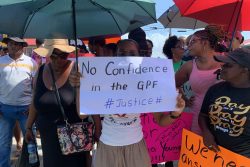 At the time of writing this, a declaration had not yet been made for the general and regional elections which were held in March. Many have lost hope while some still cling steadfast to whatever narratives are served up daily by their media outlet of choice.
At the time of writing this, a declaration had not yet been made for the general and regional elections which were held in March. Many have lost hope while some still cling steadfast to whatever narratives are served up daily by their media outlet of choice.
Today, I am taking an introspective look at our leaders and their lives with the hope of finding some clues of what might be to come, with careful reflection on how I previously interpreted them.
In 2015, David Granger rose like liberator – a knight in shining armour. He began his presidency on a natural high. After years of blatant corruption, nepotism, and extra-judicial killings paired with Guyana being famed for its underground narco-economy, gold smuggling, human trafficking and arms-trading rackets, it was easy for him to appear as a saint when compared to his opponent. He understood optics as well. I remember as clear as day seeing the picture of him driving himself to church after he was sworn in.

I also remember driving that same Sunday and being in a panic to put on my seat belt because I knew the game had been changed in some strange way. Mr Granger’s style mirrored his military background and history. He opted for uniformity and standardization, sticking mostly with the colour black and many times ditching the tie. A trend that has been seen time and time again among the likes of Obama, Prince Harry et al. This is typically done to come across as accessible to the people and less stuffy, the same way the avoidance of sunglasses is encouraged.
In his visual approach, without a doubt, he appeared to be a man just like the people by removing unnecessary clothing accessories and thus coming off as accessible. It was hard to think otherwise especially when you saw his wife, Sandra Granger. She has worn the most sleeveless dresses I have ever seen one single woman wear. She has also done so routinely ever since her husband was sworn in. After so many years of Eurocentric standards and forced dress codes at public offices, this was welcomed.
The two swung in a whole new direction that would even see David Granger’s iconic look being mimicked by schoolchildren on career day. They became predictable style-wise and thus carved out their individual status quo iconic looks, the same way other leaders do, for example, Germany’s Chancellor Angela Merkel in her solid colour jacket and black trousers look.
On top of that, we have seen them both embrace cultural wear from Guyana’s two main ethnic groups (sometimes appearing in fabric-matching outfits like young teenagers in love) aggressively trying to visually mend our severely damaged social fabric. Despite the children wanting to look like David Granger on career day, not much has changed in the dress code domain as it relates to public offices and neither has public perception as it relates to the history behind them.
This was evident when Lennox Shuman wore his indigenous wear, ever so proudly and rightfully, to one of the many court hearings during this extended election period and received a barrage of mockery for being authentic.
While we have seen relatively good image management as it relates to dress, this did not transition to the ability to influence when it came public institutions. Coupled with Mr Granger’s limited press briefings, that militant straightforward style takes points away from him being accessible despite looking so and leans more towards the possible reality of him being unreachable.
On the other side of the coin, the presidential candidate Irfaan Alli from whom we hardly ever hear anything, has embraced the standard presidential look. Opting for the standard suit and bold red tie. It would be apparent though that while silent he does observe and seemingly takes in what is going on. For most of his political career, he has dressed the same way. So, like many, I was surprised when I saw him pop on my timeline in a ‘Grangeresque’ uniform at a dental visit. Then there was a TV interview where he appeared to be wearing something very similar.
He doesn’t say much, so it is hard to guess his motives. Is he signalling that he wants to appear accessible to the people the way Mr Granger did in 2015? Is he showing that he observes positives from his opponents and would like to draw them in? Only time will tell.
His wife, on the other hand, from what is made available publicly via her Facebook profile paints a clear picture of an ‘ideal’ family life with glossy, professional, family photos of Eurocentric high tea afternoons, and well-orchestrated and decorated birthday/celebratory gatherings. This projects aspirational living that the average man can’t afford, but still manages to drive desire. There is a similarity to Lisa Hanna (Jamaican politician) but the photos fail to display individuality and even a slight sense of any national identity. For now, it seems like they are showing two different directions, but what is clear is that they both pay attention to what is trending. Perhaps the reality will be evident when the public holds their social media court. They might possibly act fast to relate.
Just like we have had to wait for elections results, only time will tell how the style choices which are categorically influenced by personal values will transfer into leadership and influence.










